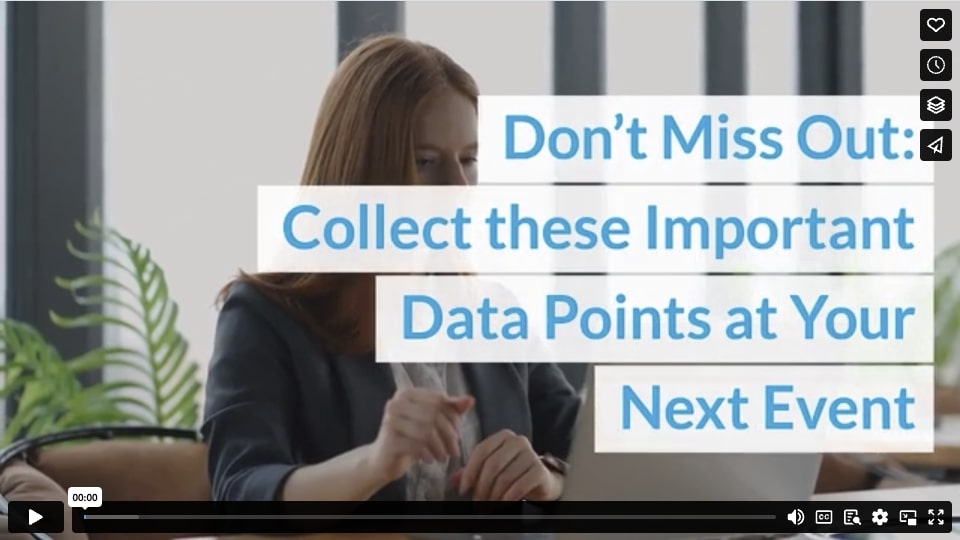When hosting an important live event, your planning attention can be torn between a million different things—booking the right keynote speakers, ordering enough food and drink, picking the perfect venue, and so much more. It is easy to let things slip through the cracks. However, one you should never forget about is data tracking.
What Does Data Tracking Mean for an Event?
Data tracking at a live event can be anything from tracking the overall attendance, the number of VIP upsells made, post-event surveys, food and drink sales, and more. Basically, data tracking is a great way to measure the success of an event and the satisfaction of your attendees.
While the specific data points you decide to track at a particular event will depend on your organization’s goals and the parameters for success, there are a few points not to be missed. Once all the data points are decided on, the right event tracking software can help collect information.
Must-Have Event Data
Pre-Event
1. Attendee Information
When someone registers to attend a live event, they will expect to submit several pieces of important information. This information includes their name, contact information (especially an email address), payment information, and their job title, company, and industry for corporate events. All this information can help track who the event marketing has reached.
2. Marketing Attribution
Some event tracking software programs will collect data about where registrants have come from. Did they click on your event page through email marketing? Did they see your social media ads? Organic searching via SEO? This data helps you keep track of the effectiveness of each of your marketing campaigns.
3. Event Budget and Preparation Costs
Creating a detailed event budget and keeping track of every expense can make or break an event. If you’re not tracking the exact cost of every additional item, you will not be able to accurately calculate the total event profit or loss when it’s all over.
Mid-Event Data
4. Guest Check-Ins
The big day has come and attendees are arriving. Even though you’ve already recorded the registration information for all of your guests, getting an accurate count on the number of check-ins on the day is crucial. Inevitably, the registration and check-in numbers will not match. The difference can teach you a lot about organizing and pricing future events.
Ensure that the check-in process for attendees is smooth and fast. The check-in process sets the tone for the whole event, so keep attendees happy by choosing an event check-in software that gets each guest through in seconds.
5. Landing Page Traffic
Most guests aren’t interested in downloading a separate app just for one event. Apps take up valuable space on a phone, and the idea of learning to navigate a new app only to delete it a few days later just doesn’t make sense.
To prevent this frustration, you should select an event registration software that utilizes QR codes. A custom QR code can link to an event website. Consider including a QR code on attendee badges, all signs around the event, and other prominent areas so that everyone has easy access.
Once you have your event’s site ready to go, ensure the landing page has data tracking installed. Website data tracking can include the number of site visits, time spent on each page, all guest interactions, and any sales or upsells made on the site. This information will help you to fine-tune the website and make any changes for the future.
6. Upgrades and Additional Sales
During your event, there will be a number of guests who will wish to upgrade their tickets to VIP status or make additional purchases. You should carefully track these on-site sales.
7. Who’s In The Room
With event management softwares from In the Room, you have the capability to keep track of some attendee activity that is not available with other software programs. Including QR code scanning at each talk, activity, and smaller event allows you as the organizer to keep track of which attendees are in the room at all times. Recording crowd sizes is a good indicator of attendee interest, and can help you tailor the event and others to guest preferences.
Post-Event Data
8. Guest Feedback
After any live event, all attendees should be sent a survey to gauge reactions and collect feedback. Ask guests which speakers were their favorite, which activities they most enjoyed, what changes they would make if possible, and if they have plans to return again. Gathering feedback data ensures a higher guest return rate.
9. Social Media Engagement
While social media engagement is something that any organization should be tracking all year round, it is especially important to keep track of data before and after a big event. Any significant change in engagement can indicate positive or negative reactions. Relevant social media accounts should also be provided as links in the post-event survey.
Ticket sales, attendance, and profit are the obvious data points to track for any live event. However, there is so much more information to be gathered and processed. To keep track of all of the important data points at your next event, look into live event data collection software to help simplify the process.
Infographic
When hosting an important live event, your attention is divided between many tasks. However, one thing you should never forget is data tracking. Read on to learn more in this infographic.

Video

